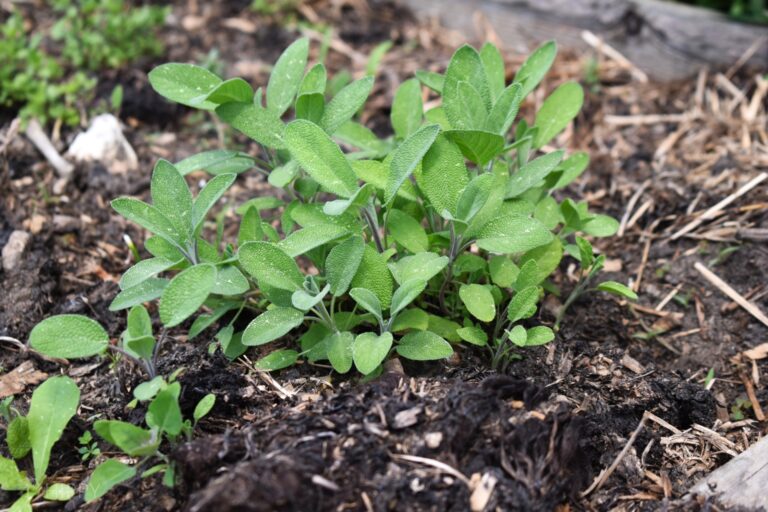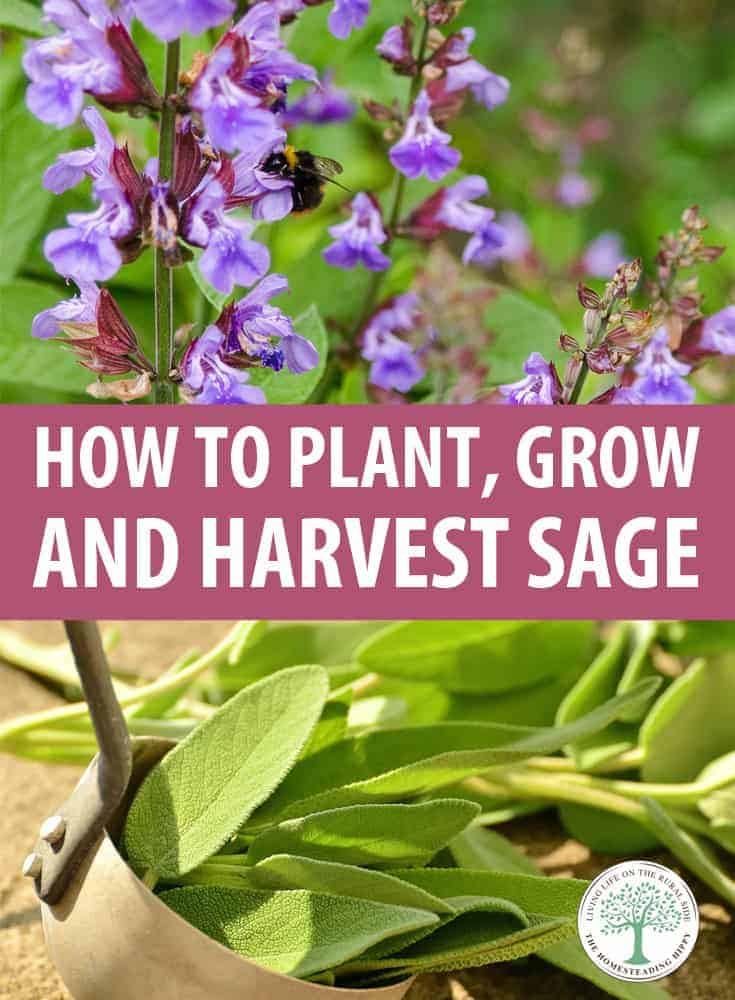Sage, salvia officinalis, is a hardy, shrubby, perennial herb and a member of the mint family. It grows pretty grayish green leaves with a pebbly texture and tall spikes of flowers in purple, blue, white, or pink.
Sage looks just as beautiful as a perennial border plant as it does in the garden or gracing your table.

Some varieties of sage have culinary purposes, while others are considered to be ornamental. In the garden, sage attracts pollinators such as butterflies and bees which benefit all of your flowering fruits, vegetables, and plants.
Sage grows equally well in containers as it does in the garden and in flowerbeds. You’ll love growing sage because it is easy to care for and doesn’t require much attention.
It boasts an intense and delicious flavor for all kinds of cooking essentials and is highly aromatic, releasing its fragrance when you brush up against it.
Sage is so hardy that has a long growing season. It’s among the first to sprout in the spring and it will even tough it out through the first few frosts of the season.
Table of Contents
How do You Use Sage?
Sage is certainly a versatile perennial and works in all kinds of dishes. Culinary sage is highly aromatic, meaning it has a strong fragrance when you crush its leaves or cook with it. It goes well with meats, dressings, and stuffings.
Sage should be used sparingly in cooking since it can easily overpower a mild dish with its strong flavor.
It can also be used for a variety of oil infusions, tasty sauces, fancy herb butters, soup, salad, breads, and even tea. Some say that smudging with sage can purify the air of germs, bacteria, and even evil.
Medicinally, sage has been used for many years for ailments such as stomach disorders, loss of memory, and even shortness of breath. Some say sage is helpful for those suffering with depression and anxiety and even regulates blood pressure.
Of course, you’ll need to discuss these benefits with your primary care physician before you make any changes to your medical care.
Sage Varieties
Culinary Sage
Culinary sage is the variety of sage that is used for cooking. The most common culinary varieties are:
- Garden Sage. Garden Sage is the most commonly grown sage and it is also the most hardy of all of the varieties. This is the one you will find most often in the kitchen garden.
- Pineapple Sage. Pineapple sage has a somewhat sweeter fragrance and flavor and is known for its bright red flowers. It goes well with fruit salad, in cocktails, and the red flowers make a beautiful and delicious garnish for green salads.
- Golden Sage. Golden sage is a variegated culinary sage that is sometimes used as an ornamental plant, as well.
- Berggarten Sage. This culinary variety has been cultivated to grow without producing flowers, because bolting reduces the flavor quality. It also bears exceptionally large, fragrant leaves.
- Tri-color Sage. This type of sage boasts beautiful colors of foliage and tastes great. It has variegated leaves of white, purple, and green and grows pretty purple flowers.
Ornamental Sage
Non-culinary varieties of sage are best used as ornamental plants. They include:
- Russian Sage. This variety bears plenty of pretty blue or lavender flowers. Even better, while it attracts pollinators, it also repels pests such as mosquitoes.
- Purple Sage. Purple sage has pretty lavender blooms but is not as hardy as other varieties. However, it is thought to be the most medicinal of all of the sage varieties and could possibly be alleviate symptoms related to digestion, cough and cold, and insect bites.
Is Sage Related to Sagebrush?
Sage, salvia officianalis, is a member of the mint family. However, sagebrush, artemisia tridentata, although it has a similar name, is actually a member of the sunflower family.
So, although the two species share similar names, they are actually very different plants from separate plant families.
Where Does Sage Grow?
Sage will grow anywhere in grow zones 4 to 11. These plants will thrive best when they are planted in area of the garden that receives full sun and also has well-draining soil.
You can get sage to grow in partial shade, but it may become spindly or leggy. You can counter legginess by pruning the tops often. Sage plants that are grown in full sun taste better than those grown in part shade.
Soil
Sage plants love well-draining soil. To prepare your garden bed for your sage plants, you will want to mix in plenty of aged compost, aged manure, or some other organic and high-quality soil amendments.
Sage will grow well with a pH between 6.0 and 7.0. If your soil is outside of this range, you can amend it. If you need to raise the pH, you could add some lime or wood ash to your soil.
If you need to lower the pH, you could add compost, peat, or even sulfur to your soil. Once you get your soil prepared, your sage plants should thrive will little care.
Plant
Sage is known for being difficult to grow from seed for several reasons. First, the seeds do not store well or long; they tend to lose their fertility quickly.
Seeds that have been stored tend to germinate poorly, so you will need to make allowances for this and attempt to germinate more seeds than you think you can use. If you do get your sage to grow from seed, it will take about two years to reach its full, mature size.
If you are a home gardener, you will probably have better luck starting sage from divisions or cuttings from other gardeners in your area. Local gardeners that have established sage patches are usually willing to share.
These sage plants will already be acclimated to the microclimate in your area, which will make it easier for them to become established in your own garden.
Starting Sage Seeds
If you are going to start your sage from seed, you’ll want to sow your seeds indoors about six to eight weeks before the last frost date. The last frost date is the last date frost is expected to happen.
You’ll want to start them under grow lights or plant lights. Remember, you’ll need to germinate more seeds than you think you will need because the germination rate is low for sage seeds.
Plant your seeds about ¼ of an inch deep into sterile seed starting soil. This will prevent tender seedlings from ‘damping off,’ or dying prematurely due to a fungal disease.
Lightly water the seeds and keep the soil damp. It should take your seeds around three weeks to germinate.
Another way to prevent the problem of avoid damping off is to water the seeds from the bottom up.
You can do this by starting your seeds in pots that have holes in the bottom. Set the pots in trays. Instead of watering the seeds from overhead, just fill the trays with water.
Seeds are ready to transplant when they are around five to six weeks along.
After the danger of a frost is over, you can harden off your seedlings and then transplant them into the garden or flowerbed.
Plant your seedlings about two feet apart. Every three to five years, you’ll want to divide your sage plants to help them grow more vigorously.
Propagation
Propagation by Cuttings in Water
Sage is easy to propagate from cuttings. Cut or snip a cutting about three to four inches from the top of the stem. Strip off the bottom leaves from your cutting, making sure to keep a few leaves at the top.
You can place your cutting in a glass of water and set it in a sunny windowsill where it should begin to grow roots within two weeks. Make sure to change out the water daily to prevent the growth of damaging bacteria.
At this point, you can plant your sage cutting into a small pot. After it has formed a rootball, you can transplant it into a larger pot or outi nto your garden.
Propagation by Cuttings in Soil
Alternatively, you can take the same type of cutting and dip the cut in rooting hormone. Plant the cutting directly into vermiculite or some sterile sand. Your sage should be ready to transplant in about six weeks.
Propagation by Layering
The third means of propagating sage is by layering. Secure a long stem to the soil with wire, making sure that the stem is in direct contact with the soil. Leave three to four inches free at the top of the plant.
In about a month, roots will form along the stem that is touching the soil. Once your sage plant has some established roots, you can cut it free from the mother plant and transplant it into a pot or somewhere else in your garden.
Companion Planting
You can companion plant sage with other vegetables. Consider planting it alongside herbs such as rosemary, and vegetables such as cabbage, tomatoes, and carrots as well as strawberries.
You’ll want to keep your sage separated from cucumbers and most other herbs for the best results. Letting your sage plants, or at least a few of them, flower will attract beneficial insects to your entire garden.
How to Grow Sage
Sage is known to be very heat and drought tolerant once the plants are mature and established. However, young plants need to have consistent moisture so they don’t dry out and wilt.
Water them regularly until they are well established and mature so they can withstand the heat of the summer.
Pruning
Sage will happily spread in your garden or flowerbed, so if it is getting too big for its spot or if it needs shaping, you can prune it to get it under control. If you are going to do a heavy pruning, it’s best to do that in the winter while the plant is dormant.
This will also help prepare the plant for fresh, new growth in the spring. If you are going to do just a little bit of pruning, you can prune it at any time.
Remember to prune your sage in the winter before the spring growth begins. Start by pruning away the larger, woody stems to make room for new growth.
The larger, woody stems won’t grow as much usable foliage, so its ok to take them away and will actually improve the quality of your plants.
You may also want to remove some of the inner stems to allow for a little more airflow through your plant. This will help prevent fungal issues and powdery mildew from forming on the leaves when it is humid.
If you like, you can prune back the entire plant to leave just a few inches at the end of the growing season. This will encourage a healthy new plant to begin growing when winter is over.
At any time, you can prune away a diseased or dying branch, or healthy foliage that you would like to use for cooking. If the plant is small or in its first year, try to harvest sparingly so the plant can reach maturity.
Once it is established and growing, you’ll be able to harvest a lot of foliage as long as you leave a few stems to help regrow your plants.
Divide the plants every three to five years to keep them growing vigorously. If this isn’t enough to keep them growing, you may need to entirely replace your plants every couple of years.
Watering
When plants are young, sage needs to be watered several times per week to keep the soil consistently moist. As plants mature, reduce watering to once a week or less.
Established plants are drought tolerant and will not need watered frequently. It is better to underwater sage plants than overwater, so you probably don’t need to worry about having someone water your sage plants while you are out of town.
Harvesting
Sage can be harvested as needed by pinching off a leaf of sprig at a time to use in cooking. Sage has a strong flavor so you don’t need much for culinary purposes.
However, in the first year, don’t overdo harvesting leaves or stems from your sage plants so they can grow and mature fully. Once the plant is mature, you can harvest much more sage at a time, but leave a few stalks behind so the plant can continue to grow.
Preservation
Sage is best used when it is fresh from the plant, however, you can dry and store sage if desired. The dried leaves will have a slightly different flavor from the fresh leaves.
You can easily dry sage plants by tying cuttings in bunches and hanging them upside down. You’ll want to dry them in a dark, well-ventilated room. You can remove the leaves once they are dry and store them whole.
You could also clip off individual leaves and dry them in your dehydrator if you need them to be dried more quickly.
Alternatively, you can store sage in the freezer. Freeze individual leaves or stalks on a tray and then transfer them to plastic bags or containers after they are frozen. You’ll be able to take out just the amount of sage you need for your recipe.
Another way to freeze sage is to freeze individual leaves in ice cube trays filled with water or oil. Once the trays have frozen, you can empty the cubes into a freezer bag or other plastic container and keep it in the freezer.
Again, you’ll be able to use just the amount that you need and you can keep the rest frozen for another time.
Pests and Diseases
Overall, sage plants tend to be hardy and disease free, especially when grown in healthy conditions.
A healthy plant isn’t like to attract pests or have problems. However, there are a few common pests that can attack sage as well as any other herbs or vegetables in your garden.
For example, you might find the following issues with your sage plants:
- Spider Mites. Spider mites are tiny pests that are related to spiders. You may have spider mites if you see white webbing on the underside of the leaves.
- Aphids. If you have an aphid infestation, you may see sticky sap on your plant, or you may see leaves that are curling up and turning yellow.
- Whiteflies. Whiteflies appear as tiny, triangular, white insects on the leaves of your plants.
- Powdery Mildew. Powdery mildew appears as white musty-looking spots on the leaves of your plants. If untreated, it will cover all of the leaves and begin to turn the plant yellow.
- Rust. Rust appears first as white spots, then as reddish-orange pustules which can break open and spread.
- Stem Rot. This fungus infection in the stem can live in soil for up to five years.
- Fungal Leaf Spots. This looks like brown or black spots on your leaves. The spots may spread and cause whole leaves to drop.
The best treatment for pests and diseases is prevention. For spider mites and other pests, keep weeds and garden debris away from your sage and herb garden to remove the possibilities of those things acting as hosts for garden pests.
If plants are severely infected with spider mites, remove them, bag them, and put them in the trash and away from your garden and compost piles.
If necessary, consider an organic pesticide such as neem oil. If this doesn’t work, you may need to take more severe measures to protect your plants and your garden.
For fungal diseases like powdery mildew, avoid watering the plants from overhead. Water your sage plants at the base instead.
Remove some internal woody stems to create room for airflow within the plant. And always space plants appropriately to allow for airflow in between plants.
Growing Sage Indoors
Sage can be grown indoors if you have enough light for it to grow. A sunny window might be enough to offer your sage plant the six to eight hours of sun that it needs to grow and thrive.
If not, you may need to add some grow lights or plant lights to add additional light to fuel your plant. Sage also needs well-draining soil in a pot that has good drainage holes so that it doesn’t sit in water.
For best results, take several cuttings from your outdoor sage plants and root them in water. Once the cuttings have grown roots, you can pot them into soil that drains well.
Sage is a delicious, nutritious herb that is easy to care for and beautiful to admire. Once the plants are established, they are easy to care for and require almost no attention.
Sage plants taste great, smell wonderful, and attract all kinds of pollinators to your gardens and flower beds.


Amanda is a homesteader and a Jesus-loving, mother of 6 toddlers. She’s raising lots of fancy chickens and goats on her small homestead (among other things). Find out more about the team here.

Always love you’re information. thank you. keep up the good work
Just for fun plant ‘Lady in Red’ variety of tropical sage. Pretty, blooms spring summer and fall, freezes, then comes back from seed every year.